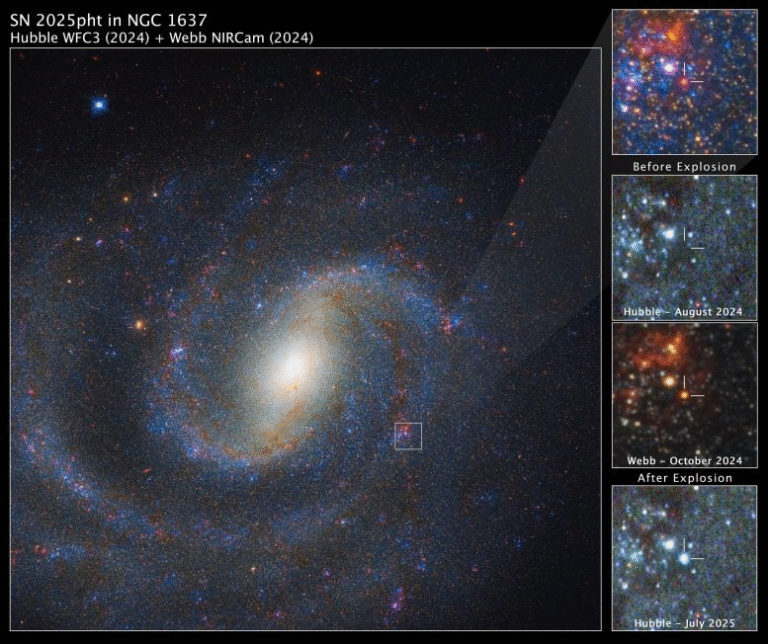New Experiments Reveal How Buckyballs May Form Naturally in Deep Space

Scientists have taken a major step toward understanding how some of the most fascinating carbon molecules in the universe—fullerenes, including the well-known buckyballs—might form in the harsh and lonely conditions of interstellar space. A team led by researchers at the University of Colorado Boulder has recreated key aspects of deep-space chemistry inside a laboratory on Earth, uncovering a surprising mechanism that could explain how simple carbon structures evolve into the spherical carbon cages drifting between the stars.
Their work focuses on the interstellar medium, the vast space between stars filled with extremely diffuse clouds of gas, dust, and a wide variety of complex organic molecules. Among these molecules are polycyclic aromatic hydrocarbons (PAHs)—flat, honeycomb-like carbon structures—and the far more elaborate fullerenes, which include C₆₀, a perfectly symmetrical carbon sphere shaped like a soccer ball. For decades, astronomers have detected fullerenes in space but struggled to identify how they formed. The new study offers one of the clearest clues so far.
Understanding the Role of Carbon in Space
Carbon is one of the most abundant elements in the universe and the backbone of organic chemistry. In space, carbon-bearing molecules endure extreme conditions, from intense cosmic radiation to frigid temperatures. How these molecules transform and survive has direct implications for star-forming regions, the formation of planetary systems, and the organic inventory that eventually seeds planets like Earth.
PAHs are particularly abundant, not just in the cosmos but also here on Earth—found in smoke, soot, charred food, and various byproducts of combustion. They are built from rings of carbon atoms arranged in hexagons, similar to the structure of graphite. Fullerenes, on the other hand, are closed carbon cages, and their formation requires the introduction of pentagonal rings that allow the structure to curl and eventually close.
Understanding how these pentagons appear from flat PAHs has been a major missing piece. The new experiments directly address this.
Recreating Space Chemistry in the Laboratory
The CU Boulder–led research team conducted their experiments on two small PAHs: anthracene and phenanthrene, each made of 14 carbon atoms and 10 hydrogen atoms but arranged differently. These molecules served as ideal test cases because they are simple, well-understood, and representative of larger PAHs found in space.
To mimic the effects of high-energy radiation in the interstellar medium, the team bombarded the PAHs with an electron beam. In space, similar interactions occur when molecules encounter cosmic rays, high-energy electrons, and ultraviolet radiation.
This bombardment caused the PAHs to lose one or two hydrogen atoms, generating reactive, charged fragments. What the researchers observed next was completely unexpected.
A Surprising Molecular Transformation
Instead of maintaining their original shapes with minor damage, the ionized PAHs rearranged themselves into completely new structures. The removal of just one or two hydrogen atoms triggered a radical internal transformation, reorganizing the carbon skeleton into new shapes containing both hexagonal and pentagonal rings.
Even more surprising, both anthracene and phenanthrene produced the same rearranged ion, despite starting from different structural configurations. This suggests a common, stable outcome of this type of radiation-induced reaction.
The presence of pentagonal carbon rings is critical, because pentagons are required for carbon sheets to fold into spherical shapes. This makes the newly observed rearranged structures promising candidates as intermediate steps between flat PAHs and fullerenes like C₆₀.
Until now, no laboratory experiment had demonstrated such spontaneous pentagon formation in PAHs under space-like conditions.
Analyzing the New Structures
To determine the exact shapes of the rearranged molecules, researchers transported the fragments to the FELIX (Free Electron Lasers for Infrared eXperiments) Laboratory in the Netherlands. FELIX is a unique facility equipped with specialized infrared lasers that allow scientists to probe the structure of isolated ions in great detail.
The team used an ion trap apparatus to hold the charged molecules and then examined them with infrared spectroscopy, comparing the results against theoretical predictions generated by density functional theory (DFT). This combination of experimental probing and computational modeling revealed how the carbon atoms had reorganized after losing hydrogen.
The data confirmed that the new structures contained the essential pentagonal rings that transform flat carbon molecules into curved ones.
Linking Laboratory Findings to the Cosmos
The discovery is more than a chemical curiosity; it potentially answers a major question in astrochemistry. Fullerenes have been observed in a variety of cosmic environments—from the shells of dying stars to interstellar clouds—but their origins remained unclear. Some theories proposed that fullerenes assembled from the bottom up, atom by atom. Others argued they formed from the top down, with large PAHs breaking down and folding into cages.
The new evidence strongly supports the top-down pathway, showing that radiation can reshape PAHs into more compact forms that serve as stepping-stones toward fullerene formation.
Because the experiments reveal distinct infrared signatures, astronomers now have new “fingerprints” they can search for in space using powerful observatories like the James Webb Space Telescope. Detecting these intermediate molecules in interstellar clouds would provide strong confirmation of this formation pathway.
Why Buckyballs Matter in Space
Buckyballs, especially buckminsterfullerene (C₆₀), play intriguing roles in the cosmic environment. They are remarkably stable, able to survive intense radiation, high temperatures, and the vacuum of space. Their resilience makes them excellent carriers for carbon through long cosmic timescales.
Fullerenes have also been found in meteorites, suggesting they can travel from interstellar space to planetary surfaces. Their structural stability and carbon-rich nature make them important to studies of prebiotic chemistry—the chemical steps that lead to life.
Understanding how fullerenes originate contributes to a larger picture of how complex carbon molecules evolve and move through galaxies, potentially influencing the early chemical environments of forming planetary systems.
Extra Background: What Makes Fullerenes Special?
Fullerenes are part of a broader family of carbon allotropes that includes graphite, diamond, and graphene. What sets fullerenes apart are their closed, cage-like shapes, which range from small spheres to elongated tubes.
Some additional points about fullerenes:
- C₆₀ contains 60 carbon atoms arranged in 12 pentagons and 20 hexagons.
- They exhibit unique electronic properties, making them useful in nanotechnology, photovoltaics, and materials science.
- Their discovery in 1985 led to a Nobel Prize in Chemistry in 1996.
Seeing these molecules in space demonstrates nature’s ability to form complex carbon structures under extreme conditions.
Extra Background: What Are PAHs?
PAHs are among the most common organic molecules in the universe and are thought to contribute significantly to interstellar infrared emission. Despite their prevalence, their life cycle is still not fully understood.
Key facts about PAHs:
- They form from fused benzene rings.
- They are flat and planar, unlike the curved fullerenes.
- In space, they may undergo repeated cycles of ionization, hydrogen loss, and chemical processing.
- Their transformations could seed the early solar nebula with complex organic compounds.
Understanding how PAHs evolve helps scientists reconstruct pathways that lead from simple carbon molecules to the complex chemistry associated with planetary formation.
What Comes Next?
The researchers plan to expand their work to larger PAHs to see whether similar rearrangements occur and whether the molecules continue to curve into fullerene-like shapes. Further astronomical observations may soon reveal whether these pentagon-bearing intermediates truly exist among interstellar clouds.
If so, the mystery of how buckyballs form in space may finally be close to being solved.
Research Paper:
Radical Isomerization upon Dissociative Electron Ionization of Anthracene and Phenanthrene – https://doi.org/10.1021/jacs.5c08619





